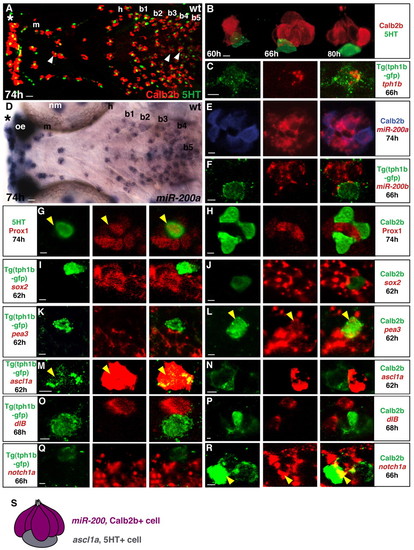Fig. 1
- ID
- ZDB-FIG-110804-10
- Publication
- Kapsimali et al., 2011 - Fgf signaling controls pharyngeal taste bud formation through miR-200 and Delta-Notch activity
- Other Figures
- All Figure Page
- Back to All Figure Page
|
Taste buds are patterned in the zebrafish oropharynx and composed of distinct cell types. Marker expression in developing taste buds. Experimental conditions are indicated in the top right-hand corner, embryonic stage and scale bar are in the bottom left-hand corner and marker expression is in the bottom right-hand corner or on the left or right. Anterior is towards the left. (A,D) Ventral views of whole-mount zebrafish larvae heads showing taste bud cells expressing Calb2b (A, red), 5HT (A, green) or miR-200a (D, blue). Asterisks indicate the row of taste buds localized in the lips. Arrowheads in A indicate palate taste buds. Scale bar: 10 μm. (B) Confocal images showing the shape of the developing taste bud organ. (C) Optical section (1 μm) showing co-expression (yellow) of tph1b mRNA and GFP expression in Tg(tph1b:egfp) larva. (E-R) Optical sections (0.5-1.5 μm) showing the relationship between Calb2b, 5HT or Tg(tph1b:egfp) and other taste bud marker expression. Yellow arrowheads indicate marker co-expression in a single cell. (E) Most miR-200a (red) cells express Calb2b (blue). Scale bars: 2 μm. (S) The main markers discriminating Calb2b+ (purple) and 5HT+ (gray) cells. b1-b5, branchial arches 1-5; h, hyoid arch; m, mandibular arch; nm, neuromast; oe, olfactory epithelium. |
| Genes: | |
|---|---|
| Antibodies: | |
| Fish: | |
| Anatomical Terms: | |
| Stage Range: | Pec-fin to Protruding-mouth |

